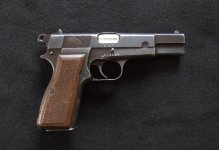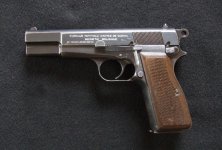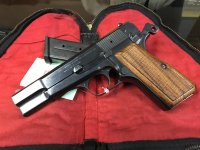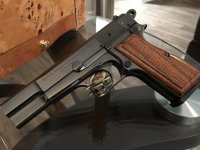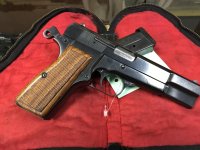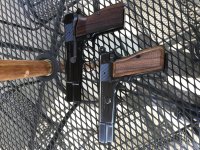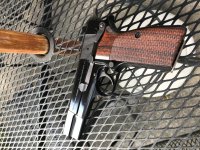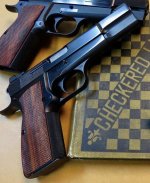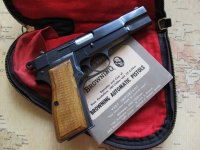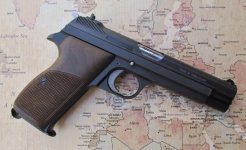I have a bit of a weakness for the Browning Hi Power. I don't like them as shooters much, but I love the way they look and I love the history and military pedigree they carry with them. Having said that, I'm very particular about which Hi Powers I buy these days. The clones do nothing for me, nor do the later cast FN/Browning models. I don't even buy the Portuguese assembled models. The newer "black" painted finish or the nickel and chrome models don't interest me either. Nope, they have to be the old forged models only from Belgium with the blued steel and wood grips. While Hi Powers from this era are starting to cost some money, they are also always going up in value. Unlike other guns, I don't buy "shooter grade" Hi Powers either, mainly because I don't really shoot them much. The only Hi Power I like to shoot is my Browning GP Competition, which is a different animal altogether.
The Browning Hi Power is the most iconic 9mm of all time, in my opinion, and still my favorite due to its military pedigree and sleek looks. It was the last handgun designed by John M Browning. Development started in the early 1920's when FN commissioned John Browning to design a new military firearm. The criteria of the design, among other things, was the ability of the pistol to hold at least 10 rounds. The fact that the 1911 patents had not yet expired meant that JMB had to design an almost entirely new pistol. Browning built a couple prototypes for the pistol and finally filed one for patent in 1923. It used a new staggered magazine designed by Dieudonne Saive. Sadly, Browning died in 1926 before the patent was even granted, let alone having finalized the design. To make a very long story short, Saive took over the development of the pistol and after numerous changes to the design once the 1911 patents expired, the gun's design was finally completed in 1934 and ready for production by FN in Belgium. The design featured a magazine disconnect, an internal extractor, and 13 rounds of capacity. That made the Hi Power the first hi-cap 9mm auto, hence the name "Hi Power".
The pistol was first adopted for use in the Belgian military in 1935 and from then on, the Hi Power also became known as the P35. The gun was heavily used by both sides during World War II and saw military use all over the world in the decades to follow. As with many pistols in production so long, the model included numerous variants and even underwent some design changes along the way. The Hi Power was offered with many finishes over the years, but was always a full carbon steel pistol that featured a forged slide and frame for most of its life. In recent decades, production changed to casting instead of forging to make the pistol capable of handling the 40S&W round.
I bought this one because the condition is about as mint as it was the day it left Belgium in the late 1960's. The T series Browning Hi Powers from the mid to late 1960's are widely regarded as the high water mark for the model by many people. It still had the workmanship of the earlier Hi Powers, but it also had a nicer bluing than models made before it. True to that, this gun has a beautiful semi glossy blued finish, which is definitely a step up over my Hi Powers from the earlier part of the decade. As you can see in the group picture below, its not my only T Series. In fact, my other one is just as nice. However, being that the model is now discontinued and gems like this will become harder and harder to find, I figured "what the hell". Value will continue to rise as more years go by.
Thanks for reading. Please enjoy the pics and share your thoughts...











Here it is with my other BHP's. I have thinned the heard a bit, but kept all the collectible examples.
Left to right: 1960, 1962, 1968, 1969, 1972 Sport, 1981 GP Competition.


The Browning Hi Power is the most iconic 9mm of all time, in my opinion, and still my favorite due to its military pedigree and sleek looks. It was the last handgun designed by John M Browning. Development started in the early 1920's when FN commissioned John Browning to design a new military firearm. The criteria of the design, among other things, was the ability of the pistol to hold at least 10 rounds. The fact that the 1911 patents had not yet expired meant that JMB had to design an almost entirely new pistol. Browning built a couple prototypes for the pistol and finally filed one for patent in 1923. It used a new staggered magazine designed by Dieudonne Saive. Sadly, Browning died in 1926 before the patent was even granted, let alone having finalized the design. To make a very long story short, Saive took over the development of the pistol and after numerous changes to the design once the 1911 patents expired, the gun's design was finally completed in 1934 and ready for production by FN in Belgium. The design featured a magazine disconnect, an internal extractor, and 13 rounds of capacity. That made the Hi Power the first hi-cap 9mm auto, hence the name "Hi Power".
The pistol was first adopted for use in the Belgian military in 1935 and from then on, the Hi Power also became known as the P35. The gun was heavily used by both sides during World War II and saw military use all over the world in the decades to follow. As with many pistols in production so long, the model included numerous variants and even underwent some design changes along the way. The Hi Power was offered with many finishes over the years, but was always a full carbon steel pistol that featured a forged slide and frame for most of its life. In recent decades, production changed to casting instead of forging to make the pistol capable of handling the 40S&W round.
I bought this one because the condition is about as mint as it was the day it left Belgium in the late 1960's. The T series Browning Hi Powers from the mid to late 1960's are widely regarded as the high water mark for the model by many people. It still had the workmanship of the earlier Hi Powers, but it also had a nicer bluing than models made before it. True to that, this gun has a beautiful semi glossy blued finish, which is definitely a step up over my Hi Powers from the earlier part of the decade. As you can see in the group picture below, its not my only T Series. In fact, my other one is just as nice. However, being that the model is now discontinued and gems like this will become harder and harder to find, I figured "what the hell". Value will continue to rise as more years go by.
Thanks for reading. Please enjoy the pics and share your thoughts...











Here it is with my other BHP's. I have thinned the heard a bit, but kept all the collectible examples.
Left to right: 1960, 1962, 1968, 1969, 1972 Sport, 1981 GP Competition.






